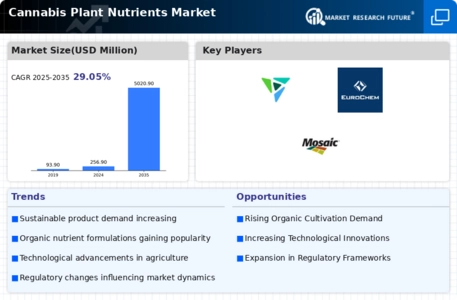Market Share
Cannabis Plant Nutrients Market Share Analysis
The global rise in the prevalence of chronic diseases, including conditions such as chemotherapy-induced nausea and vomiting, epilepsy, spasticity linked to multiple sclerosis or spinal cord injuries, fibromyalgia, glaucoma, and others, has led to a growing demand for medications derived from cannabis. Substantial evidence supports the effectiveness of cannabis as a key ingredient in medicines used to address various diseases, further propelling its adoption in the healthcare sector.
Beyond its direct therapeutic benefits, the use of medical cannabis has demonstrated additional advantages, notably in reducing reliance on opiate medications and minimizing the likelihood of associated side effects. A study highlighted in the Journal of Pain Home Page reported a significant 64% reduction in opioid use in 2016, attributed to the increasing adoption of medicines based on cannabis. This shift not only reflects the efficacy of cannabis-derived treatments but also contributes to an enhanced quality of life for patients.
Further emphasizing the evolving landscape, a web-based survey conducted in 2020 among the Australian population, specifically focusing on individuals with epilepsy, revealed notable trends. Out of 976 respondents, 137 reported utilizing cannabis products for managing their seizures. This underscores the growing acceptance and utilization of cannabis-based remedies within specific patient communities. Additionally, a report from the Australian Institute of Health and Welfare disclosed a substantial increase in preference for cannabis use for medicinal purposes among Australians. In 2020, 87% of respondents expressed a preference for cannabis, marking a notable increase from 74% in 2019. This shifting sentiment indicates a broader recognition of cannabis's therapeutic potential and a willingness to explore alternative treatment options.
The expanding application of cannabis within the healthcare industry is anticipated to be a key driver for the growth of the global cannabis plant nutrients market in the forecast period. As the demand for cannabis-based medications continues to rise in response to the increasing prevalence of chronic diseases, the market for associated plant nutrients is expected to experience significant growth. The dynamic relationship between the healthcare sector and cannabis-based solutions reflects a changing landscape where alternative therapies are gaining traction and contributing to the evolution of medical treatments.
The escalating global prevalence of chronic diseases has spurred a heightened demand for cannabis-derived medications, supported by substantial evidence of their efficacy. The use of medical cannabis not only addresses specific medical conditions but also offers advantages such as reduced reliance on opioids, leading to an improved quality of life for patients. This trend is evident in various regions, as seen in the Australian context, where a growing number of individuals are turning to cannabis-based products for managing health conditions. The increasing integration of cannabis within the healthcare sector is anticipated to drive the growth of the global cannabis plant nutrients market in the foreseeable future. The evolving perception of cannabis as a viable and effective medical option underscores the broader transformation occurring in healthcare practices and patient preferences.

















Leave a Comment